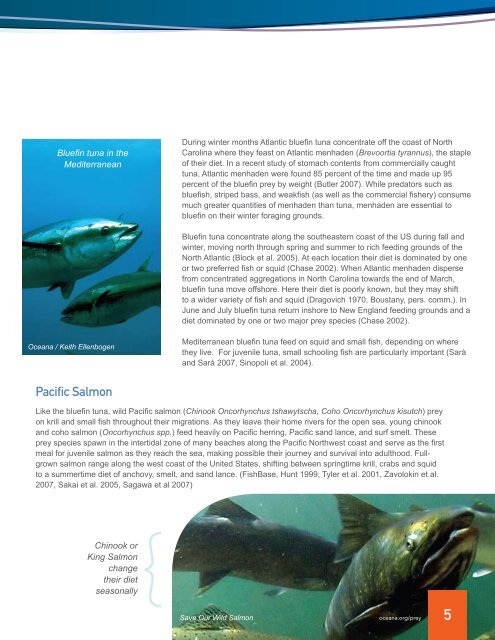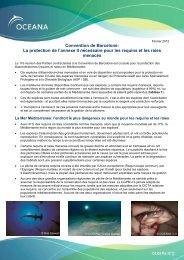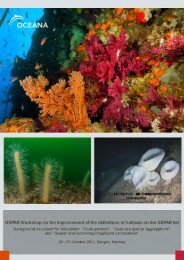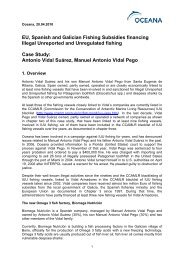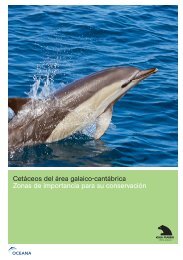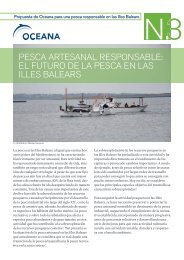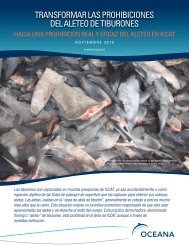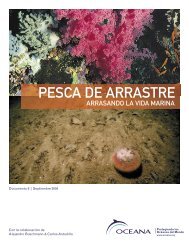You also want an ePaper? Increase the reach of your titles
YUMPU automatically turns print PDFs into web optimized ePapers that Google loves.
Bluefin tuna in the<br />
Mediterranean<br />
<strong>Oceana</strong> / Keith Ellenbogen<br />
Pacific Salmon<br />
During winter months Atlantic bluefin tuna concentrate off the coast of North<br />
Carolina where they feast on Atlantic menhaden (Brevoortia tyrannus), the staple<br />
of their diet. In a recent study of stomach contents from commercially caught<br />
tuna, Atlantic menhaden were found 85 percent of the time and made up 95<br />
percent of the bluefin prey by weight (Butler 2007). While predators such as<br />
bluefish, striped bass, and weakfish (as well as the commercial fishery) consume<br />
much greater quantities of menhaden than tuna, menhaden are essential to<br />
bluefin on their winter foraging grounds.<br />
Bluefin tuna concentrate along the southeastern coast of the US during fall and<br />
winter, moving north through spring and summer to rich feeding grounds of the<br />
North Atlantic (Block et al. 2005). At each location their diet is dominated by one<br />
or two preferred fish or squid (Chase 2002). When Atlantic menhaden disperse<br />
from concentrated aggregations in North Carolina towards the end of March,<br />
bluefin tuna move offshore. Here their diet is poorly known, but they may shift<br />
to a wider variety of fish and squid (Dragovich 1970, Boustany, pers. comm.). In<br />
June and July bluefin tuna return inshore to New England feeding grounds and a<br />
diet dominated by one or two major prey species (Chase 2002).<br />
Mediterranean bluefin tuna feed on squid and small fish, depending on where<br />
they live. For juvenile tuna, small schooling fish are particularly important (Sarà<br />
and Sarà 2007, Sinopoli et al. 2004).<br />
Like the bluefin tuna, wild Pacific salmon (Chinook Oncorhynchus tshawytscha, Coho Oncorhynchus kisutch) prey<br />
on krill and small fish throughout their migrations. As they leave their home rivers for the open sea, young chinook<br />
and coho salmon (Oncorhynchus spp.) feed heavily on Pacific herring, Pacific sand lance, and surf smelt. These<br />
prey species spawn in the intertidal zone of many beaches along the Pacific Northwest coast and serve as the first<br />
meal for juvenile salmon as they reach the sea, making possible their journey and survival into adulthood. Fullgrown<br />
salmon range along the west coast of the United States, shifting between springtime krill, crabs and squid<br />
to a summertime diet of anchovy, smelt, and sand lance. (FishBase, Hunt 1999, Tyler et al. 2001, Zavolokin et al.<br />
2007, Sakai et al. 2005, Sagawa et al 2007)<br />
Chinook or<br />
King Salmon<br />
change<br />
their diet<br />
seasonally<br />
Save Our Wild Salmon<br />
oceana.org/prey<br />
5


